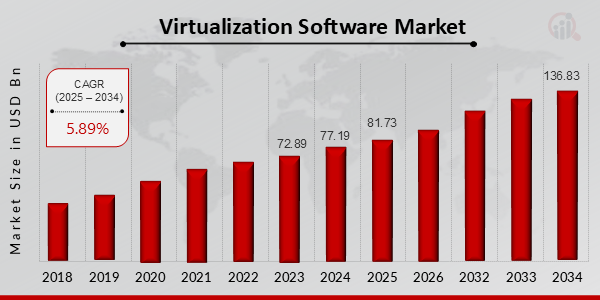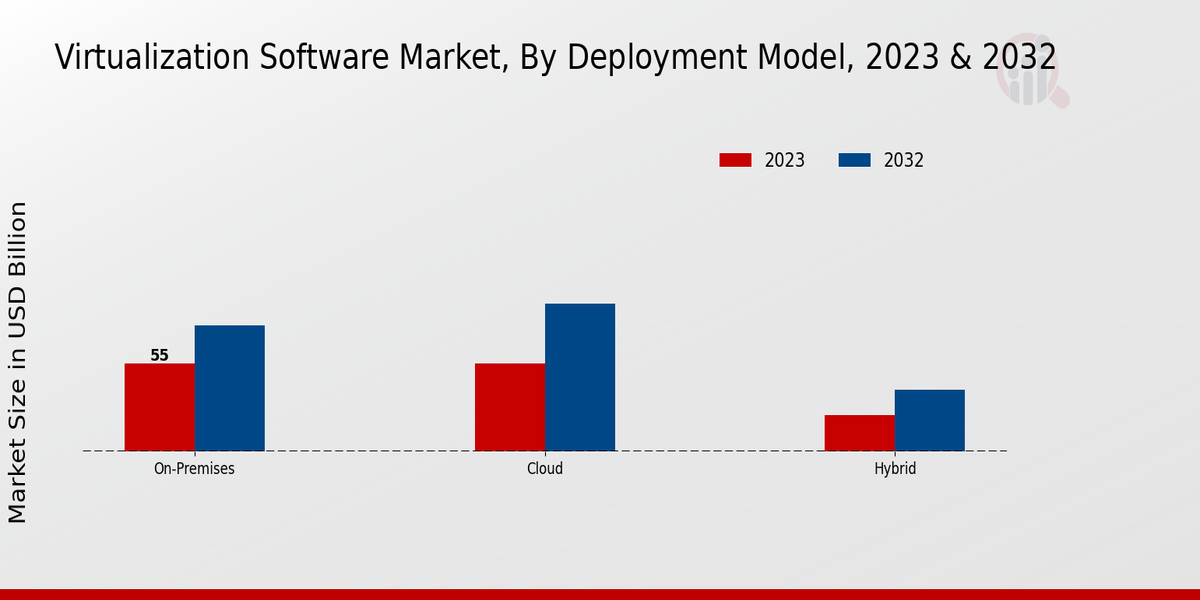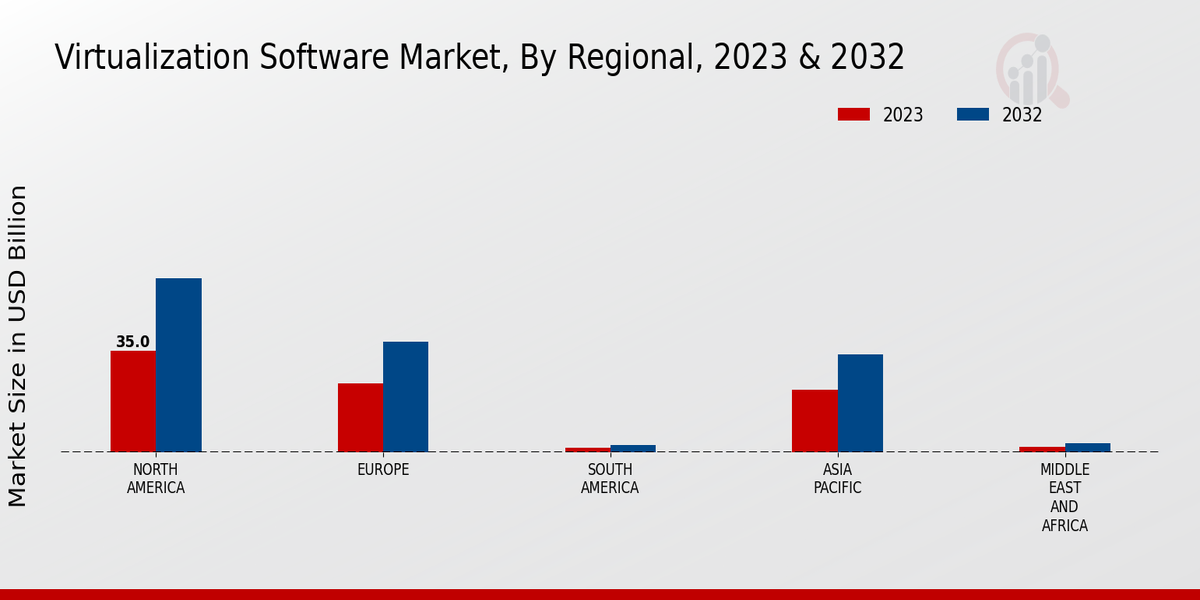Virtualization Software Market Overview
Virtualization Software Market is projected to grow from USD 81.73 Billion in 2025 to USD 136.83 Billion by 2034, exhibiting a compound annual growth rate (CAGR) of 5.89% during the forecast period (2025 - 2034). Additionally, the market size for Virtualization Software Market was valued at USD 77.19 billion in 2024.
Key Virtualization Software Market Trends Highlighted
The procedure of virtualization provides considerable benefits to organizations by gaining full use of their IT systems. Some of the market factors include the increase in the usage of cloud services, an increase in the need for speed and flexibility, and the developing trend of working from home. The growth prospects include virtualization, reaching out to new frontiers such as the use of containers and the use of desktop virtualization.
There is a current trend toward the adoption of hyper-converged infrastructure (HCI), which integrates virtualization, storage, and networking components through high-technology systems. Besides, the increase in artificial intelligence and the use of machine learning among firms are improving virtualization and its features. The market in question is still poised for growth in the years to come due to technological innovations and heightened digital transformation needs.
Figure 1: Virtualization Software Market Size, 2025-2034 (USD Billion)

Source: Primary Research, Secondary Research, Market Research Future Database and Analyst Review
Virtualization Software Market Drivers
Growing Demand for Cloud Computing and Virtualization
The Virtualization Software Market Industry is driven by the escalating adoption of cloud computing and virtualization technologies. Cloud computing provides companies with flexibility, scalability, as well as value for the offered solutions. However, virtualization enables them to reduce their IT infrastructure expenses and run their systems more effectively.
Virtualization software can help companies host multiple operating systems and applications on the same physical server, which could be impossible without key features of virtualization, such as encapsulation, hardware independence, performance optimization, and so on.It may be assumed that the growing demand for cloud computing and virtualization stimulates the increasing profitability of the Virtualization Software Market Industry.
Increasing Adoption of Virtual Desktops and Applications (VDI/VDA)
Another significant driver of the Virtualization Software Market Industry is the rising deployment of virtual desktops and applications. VDI/VDA facilitates using a desktop and an application on any device, regardless of the physical location of the device. Since more and more staff work from home or at least from multiple places, this feature is vitally essential. Moreover, it allows companies to enhance the safety of their IT infrastructure and control them more successfully.Integrating desktops and applications in a server, businesses can safeguard against viruses and other risks so their PCs operate in a more productive way.
It is expected that the rising deployment of VDI/VDA will continuously serve as a driver of the Virtualization Software Market Industry.
Rising Need for Data Center Optimization
The rising need for data center optimization is also driving the growth of the Virtualization Software Market Industry. Data centers are becoming increasingly complex and expensive to manage, and virtualization software can help businesses optimize their data center resources. By virtualizing their servers, businesses can reduce their physical hardware footprint, improve energy efficiency, and improve utilization rates. The rising need for data center optimization is expected to continue to drive the growth of the Virtualization Software Market Industry in the coming years.
Virtualization Software Market Segment Insights
Virtualization Software Market Deployment Model Insights
The Virtualization Software Market is segmented by deployment model on on-premises, cloud, hybrid. As of 2023, the on-premises segment held the largest share of the Virtualization Software Market, with over 55% of the revenue. The leading share is driven by the highest level of on-premises deployment control and customization for enterprises. At the same time, the cloud segment is projected to show the fastest growth over the forecast years, enhanced by the growing adoption of the cloud-based services and their competitive costs, flexibility, and scalability.
As for hybrid deployment, which combines the premises benefits of control with the cloud attribute of flexibility, it is expected to show increasing growth as adaptive and resilient IT infrastructure becomes an increasingly important issue for modern enterprises. The Virtualization Software Market is defined by a high number of vendors. Among the key industry players are VMware, Citrix, Microsoft, Red Hat, and Nutanix. Moreover, the market includes a substantial number of niche players that focus on the specific industry or type of application and provide specialized virtualization services.
A number of factors drive the Virtualization Software Market growth, specifically, the growing adoption of disaster recovery and business continuity solutions, the global requirement for efficient IT systems, and the cloud computing adoption trend. Virtualization software is essential for consolidating, modernizing, decreasing enterprise IT costs, and scaling agility. The development of digital technologies and the sphere of their application offer a sustainable demand for virtualization. Overall, the Virtualization Software Market shows significant growth opportunities for the future, driven by the critical levels of cloud computing use, demand for efficient IT systems, and need for disaster recovery and business continuity solutions.
The pressure of these factors is likely to result in new technologies and solutions, change, and vendor consolidation.

Source: Primary Research, Secondary Research, Market Research Future Database and Analyst Review
Virtualization Software Market Virtualization Type Insights
The Virtualization Software Market is segmented by Virtualization Type into Server Virtualization, Desktop Virtualization, Network Virtualization, and Storage Virtualization. Server Virtualization, among these segments, held the largest market share of 46.7% in 2023 and is projected to continue to lead the market during the forecast period. This type of virtualization allows multiple operating systems and applications to run on a single physical server, which enables the utilization of resources and reduced costs. Desktop Virtualization, offering users to access virtual desktops from any device, is projected to observe the most vigorous growth rate of 10.2% over the forecast period.
Network Virtualization, which decouples network resources from the underlying hardware to provide flexibility and scalability, is anticipated to expand at a CAGR of 9.5%. Storage Virtualization, which pools physical storage from multiple network storage devices into a single virtualized storage for easier management and data availability, is expected to show a growth rate of 8.3% during the forecast period.
Virtualization Software Market Organization Size Insights
The Virtualization Software Market segmentation by Organization Size can be bifurcated into Small and Medium-sized Enterprises (SMEs) and Large Enterprises. SMEs are expected to hold a significant market share due to the increasing adoption of virtualization solutions to optimize IT infrastructure, reduce costs, and improve agility. Large enterprises are also expected to contribute to market growth due to the need for robust and scalable virtualization solutions to manage complex IT environments and support mission-critical applications.
The Virtualization Software Market revenue for the SME segment is projected to reach USD 45.62 Billion by 2024, while the Large Enterprise segment is expected to generate USD 69.59 Billion by the same year. This growth is attributed to the rising demand for efficient resource utilization, enhanced security measures, and improved IT performance.
Virtualization Software Market Industry Vertical Insights
The Virtualization Software Market is expected to reach a valuation of USD 78.43 billion by 2024, exhibiting a CAGR of 6.2% during the forecast period. The market growth is primarily driven by the increasing adoption of cloud computing and virtualization technologies, the growing need for improved IT infrastructure, and the rising demand for efficient resource utilization.
Among the various industry verticals, IT and Telecom, Banking, Financial Services, and Insurance (BFSI), Healthcare, Manufacturing, and Retail are the major contributors to the Virtualization Software Market revenue.IT and Telecom industry holds a significant market share due to the high adoption of virtualization technologies for server consolidation, disaster recovery, and business continuity. BFSI industry is also witnessing a substantial growth in virtualization software adoption to enhance security, improve operational efficiency, and reduce costs. The Healthcare industry is leveraging virtualization for telemedicine, remote patient monitoring, and data management.
Manufacturing and Retail industries are utilizing virtualization for process optimization, supply chain management, and customer relationship management.
Virtualization Software Market Hypervisor Type Insights
The Virtualization Software Market is segmented by Hypervisor Type into Type 1 Hypervisor and Type 2 Hypervisor. The Type 1 Hypervisor segment held a larger market share in 2023 and is projected to continue its dominance throughout the forecast period. The growth of this segment can be attributed to the increasing adoption of cloud computing and virtualization technologies by enterprises worldwide. Type 1 hypervisors are more efficient and provide better performance compared to Type 2 hypervisors, making them the preferred choice for mission-critical applications.
Additionally, the growing need for enhanced security and isolation is driving the demand for Type 1 hypervisors. The Type 2 Hypervisor segment is also expected to witness significant growth during the forecast period due to its ease of deployment and management. Type 2 hypervisors are ideal for small and medium-sized businesses and for non-critical applications. The rising adoption of virtualization in various industry verticals, such as IT, healthcare, and education, is expected to drive the growth of the Type 2 Hypervisor segment.
Virtualization Software Market Regional Insights
The regional segmentation of the Virtualization Software Market offers valuable insights into the geographical distribution of market revenue and growth opportunities. North America is expected to dominate the market in 2023, accounting for around 35% of the global revenue. The region's high adoption rate of virtualization technologies, presence of major players, and favorable regulatory environment contribute to its leading position. Europe follows closely with a market share of approximately 28%, driven by increasing demand for cloud computing and virtualization solutions in various industries.
APAC is projected to witness significant growth over the forecast period, with a CAGR of 6.2%, due to rising IT spending and growing adoption of virtualization in emerging economies such as China and India. South America and MEA hold smaller market shares but present opportunities for growth as businesses in these regions seek to optimize their IT infrastructure and reduce costs. Overall, the Virtualization Software Market is expected to continue its growth trajectory, with regional dynamics playing a key role in shaping market dynamics and opportunities.

Source: Primary Research, Secondary Research, Market Research Future Database and Analyst Review
Virtualization Software Market Key Players And Competitive Insights
In addition to this, major market players are focusing on innovation and product development to retain their positions in the market. These players are using various strategies to expand their presence in the global market and increase their market share.
For example, in June 2023, a prominent provider of virtualization software VMware acquired Bitnami, a provider of containerized software solutions. This acquisition would help VMware to strengthen its position in the hybrid cloud market and expand its portfolio of container management solutions. The increasing adoption of cloud computing and businesses’ need to reduce their IT costs drive the development of the Virtualization Software Market. The growing demand from the BFSI, healthcare, and retail industries is also boosting the growth of the market.
VMware is one of the industry leaders in developing virtualization software and cloud computing solutions. The company offers a wide range of products and services that help businesses consolidate their IT infrastructure, reduce their costs, and improve their operational efficiency. VMware has a significant global presence and a huge customer base. The revenue of the company for the fiscal year ending January 2023 amounted to $12.87 billion. The company's main competitors are Microsoft, Citrix, and Red Hat. Microsoft is the leading provider of operating systems, productivity software, and cloud computing services.
The company competes with VMware in the virtualization market using its Hyper-V platform. Citrix is a provider of virtualization software, networking, and application delivery products and services. Its XenServer virtualization platform competes with VMware’s vSphere. Red Hat is the leading provider of open-source solutions, and its Red Hat Virtualization is a strong competitor to VMware’s vSphere.
Key Companies in the Virtualization Software Market Include
Virtualization Software Market Industry Developments
The Virtualization Software Market is anticipated to grow significantly over the forecast period, driven by increasing adoption of cloud computing and virtualization technologies. The market is expected to witness substantial growth in emerging economies, where businesses are rapidly adopting virtualization solutions to improve efficiency and reduce costs. Key market trends include the rising popularity of server virtualization, the growing adoption of containerization technologies, and the increasing demand for cloud-based virtualization services.
Major players in the market are VMware, Microsoft, Citrix, Red Hat, and Oracle, among others. Recent news developments include VMware's acquisition of Bitnami to enhance its application delivery capabilities, and Microsoft's launch of Azure VMware Solution to provide a seamless hybrid cloud experience. The market is expected to continue its growth trajectory, driven by the increasing need for efficient IT infrastructure management and the growing adoption of virtualization technologies across various industries.
Virtualization Software Market Segmentation Insights
-
Virtualization Software Market Deployment Model Outlook
-
Virtualization Software Market Virtualization Type Outlook
-
Virtualization Software Market Organization Size Outlook
- Small and Medium-sized Enterprises (SMEs)
-
Virtualization Software Market Industry Vertical Outlook
- Banking, Financial Services, and Insurance (BFSI)
-
Virtualization Software Market Hypervisor Type Outlook
-
Virtualization Software Market Regional Outlook
| Report Attribute/Metric |
Details |
|
Market Size 2024
|
77.19 (USD Billion)
|
|
Market Size 2025
|
81.73 (USD Billion)
|
|
Market Size 2034
|
136.83 (USD Billion)
|
|
Compound Annual Growth Rate (CAGR)
|
5.89% (2025 - 2034)
|
|
Report Coverage
|
Revenue Forecast, Competitive Landscape, Growth Factors, and Trends
|
|
Base Year
|
2024
|
|
Market Forecast Period
|
2025 - 2034
|
|
Historical Data
|
2019 - 2023
|
|
Market Forecast Units
|
USD Billion
|
| Key Companies Profiled |
AcronisNewparaProxmox, Microsoft, Oracle Corporation, HPE, Parallels International, Lenovo Group, Veeam Software, Cisco System, Dell Technologies, IBM, VMware, Citrix Systems, Red Hat, Nutanix |
| Segments Covered |
Deployment Model, Virtualization Type, Organization Size, Industry Vertical, Hypervisor Type, Regional |
| Key Market Opportunities |
Cloud computing hybrid cloud adoption containerization software-defined networking and edge virtualization |
| Key Market Dynamics |
Increasing cloud adoption, growing demand for remote work, rising data center consolidation advancements in hardware virtualization, expanding need for disaster recovery |
| Countries Covered |
North America, Europe, APAC, South America, MEA |
Frequently Asked Questions (FAQ):
The Virtualization Software Market was valued at USD 81.73 billion in 2025 and is expected to reach a valuation of USD 136.83 billion by 2034, exhibiting a CAGR of 5.89% during the forecast period.
North America holds the largest market share in the Virtualization Software Market, with a share of 38.7% in 2025.
The Cloud-based Virtualization segment is expected to contribute the largest share to the growth of the Virtualization Software Market, owing to the increasing adoption of cloud computing.
Virtualization Software finds applications in various industries, including IT and telecom, BFSI, manufacturing, healthcare, and retail.
Major players operating in the Virtualization Software Market include VMware, Microsoft, Citrix, Red Hat, and Oracle.
Key growth factors driving the Virtualization Software Market include the increasing adoption of cloud computing, the growing demand for data center consolidation, and the need for improved IT efficiency.
Challenges faced by the Virtualization Software Market include concerns over data security, compatibility issues, and the lack of skilled professionals.
Future opportunities for the Virtualization Software Market lie in the adoption of emerging technologies such as artificial intelligence (AI) and machine learning (ML), and the growing demand for virtualization in edge computing.
The Virtualization Software Market is projected to grow from USD 68.83 billion in 2023 to USD 115.21 billion by 2032, at a CAGR of 5.89%.
Key trends shaping the Virtualization Software Market include the rise of hyper-converged infrastructure (HCI), the adoption of software-defined data centers (SDDC), and the increasing popularity of containerization.

















